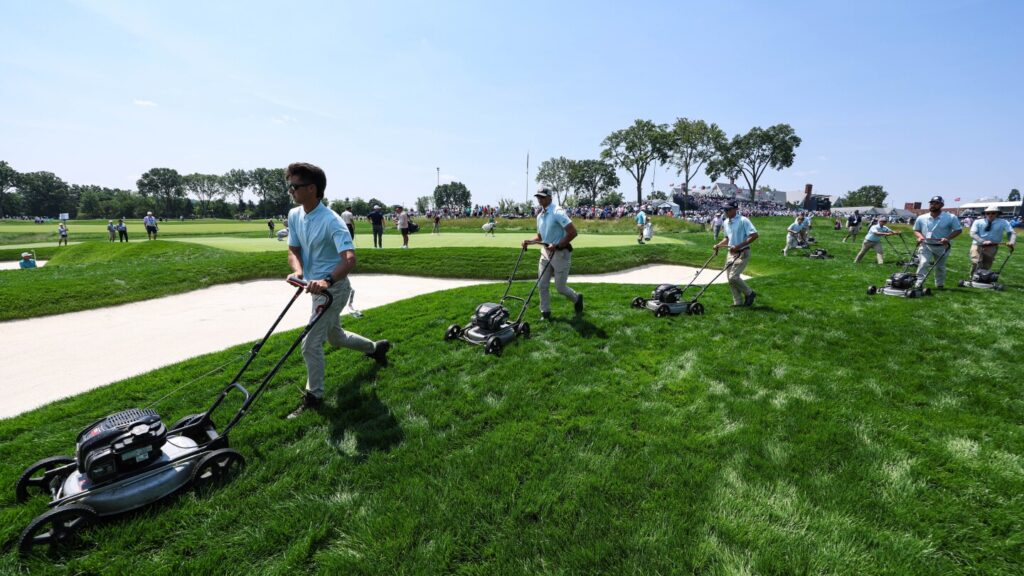OAKMONT, Pa. – The U.S. Open is synonymous with tall, thick rough. Especially at Oakmont, where the juicy mix of Kentucky bluegrass, rye and poa annua will be kept around 5 inches and change, continually manicured so that it stays upright and keeps swallowing golf balls.
It feels worse.
“Try 9 inches,” said one competitor, only half jokingly.
Jackson Koivun, the standout Auburn junior who ascended to No. 1 in the World Amateur Golf Ranking on Wednesday, has already lost a ball to the rough, on the 10th hole Monday. He’s not the only one – Bryson DeChambeau and Preston Summerhays, in the same group, had drives disappear right of the 14th fairway – and if players haven’t, it’s almost a guarantee that they and their caddies have spent multiple minutes these past few days looking for errant shots.
“This is the worst rough that I’ve seen,” said Koivun’s caddie, Chris Williams, a former world No. 1 amateur in his own right and now the Tigers’ assistant.
The rough is thriving, in part, because of a record May for rainfall in Allegheny County. Slightly bigger fairways following a recent renovation by Gil Hanse have also emboldened the USGA to be more aggressive with the setup, which includes the elimination of the graduated rough that competitors saw the last time this championship came to Oakmont, nine years ago. When you spot mowers – several dozens of them, in sync – running about the property, there isn’t much cutting being done but rather what can better be described as fluffing.
“We just felt we needed the rough that we have,” said John Bodenhamer, the USGA’s chief championships officer. “We think it’s appropriate for the driving corridors, and we’re looking forward to seeing how it unfolds.”
Of course, with this tenacious of rough comes greater responsibility to the spotters. Perhaps the most unsung of heroes this week will be the four to six skilled sets of eyes on each hole. That’s in addition to the dozen or so marshals per hole.
“This is like watching ketchup come out of a Heinz bottle, the anticipation,” said one marshal as he awaited tee shots on the par-4 17th hole during Wednesday’s practice round.
Added another, as she arrived for her shift: “I’m ready. I’ve got my sunglasses.”
They’ll be reinforced, too, as the dedicated spotters, not deployed for the practice days and 330 in total, will punch in beginning Thursday morning with the sole task of locating balls and flagging them.
“I’m glad we have spotters up there,” said Rory McIlroy, who also played Oakmont two Mondays ago in an outing, when there was absolutely no help looking for balls that missed the short grass. “… You hit a ball off the fairway and you were looking for a good couple of minutes just to find it.”
Added Ben An: “18-handicappers will not finish a round without volunteers.”
Try 13-handicappers, too. One such player who played Oakmont last month said he lost four balls in a hole and a half.
“And then I just walked in,” said the man, who is working as a spotter on the 18th hole Friday and Saturday.
One final-hole spotter for Sunday was already praying that they wouldn’t factor in the outcome: “Imagine if the leader misses one right and we can’t find it…”
Jun 9, 2025; Oakmont, Pennsylvania, USA; Alistair Docherty plays a shot from the rough on the third hole during a practice round for the U.S. Open golf tournament at Oakmont Country Club. Mandatory Credit: Bill Streicher-Imagn Images
Bill Streicher-Imagn Images
Tiger Woods might have 16 major titles if not for his lost drive on his first hole of the 2003 Open Championship at Royal St. George’s. Woods and an army of marshals spent 5 minutes looking for his Nike ‘1’ golf ball that day but to no avail. Woods had to return to the tee and would eventually finish two shots behind winner Ben Curtis.
Bodenhamer seemed confident the USGA’s platoon of pupils would ensure that every ball is found this week.
“We have plenty of spotters,” Bodenhamer said, “but no guarantees we won’t lose a golf ball or two. But we’re going to do everything we possibly can not to do so. But we feel good about that.”
Now, finding balls and playing them are different stories. Most balls nestled deep in the rough will require hacking out with a lob wedge, with some of those shots requiring players to take their swings while barely being able to see the ball. Sometimes guys will get lucky, but it won’t be often.
Oakmont’s famous SWAT games usually produce a breakeven best-ball score of 69 to 70. It’s been at least seven shots higher in recent months as the club has prepared for this U.S. Open.
“I don’t think people understand how thick the rough is,” Collin Morikawa said. “It’s not wispy like the club is going to go through. … You have to be steep to get to the ball in the rough, and when you’re steep, it delofts the face, so you’re just hitting it deeper into the earth. It’s very, very hard.”
Added McIlroy: “The person with the most patience and the best attitude this week is the one that’s going to win.”
Being the luckiest won’t hurt, either.
Read the full article here



